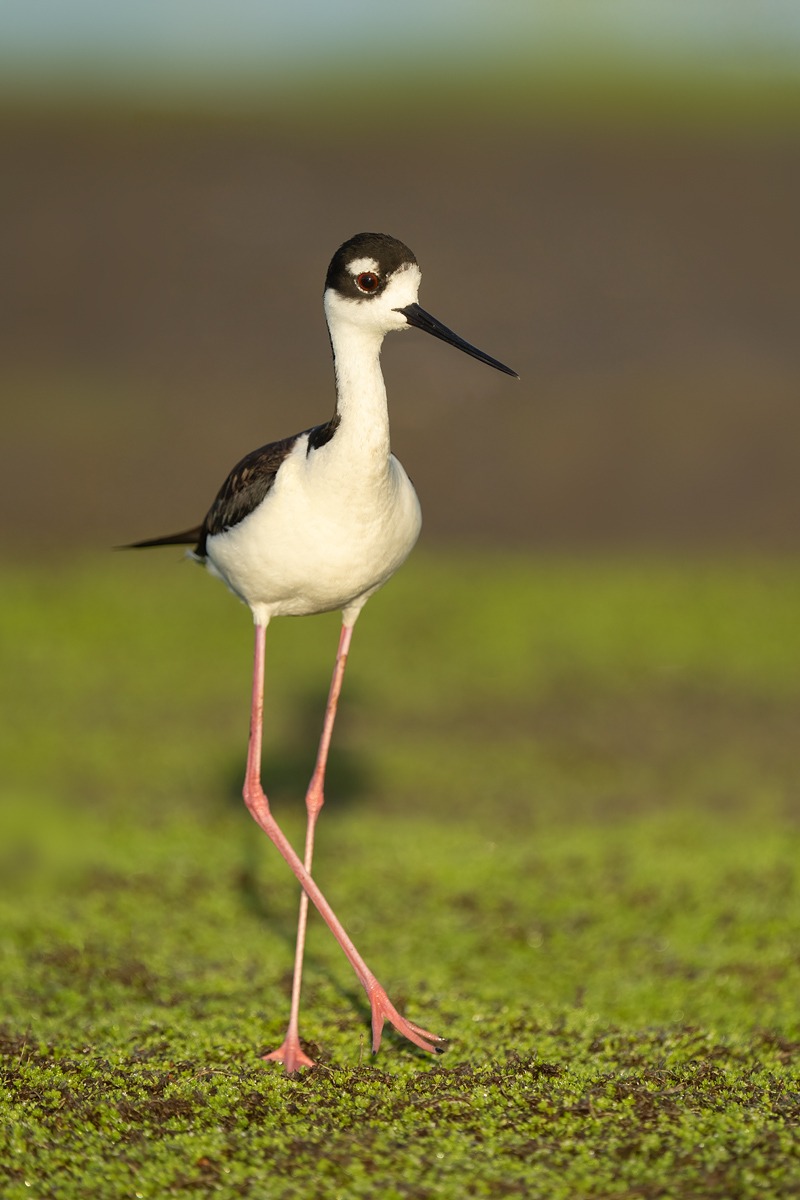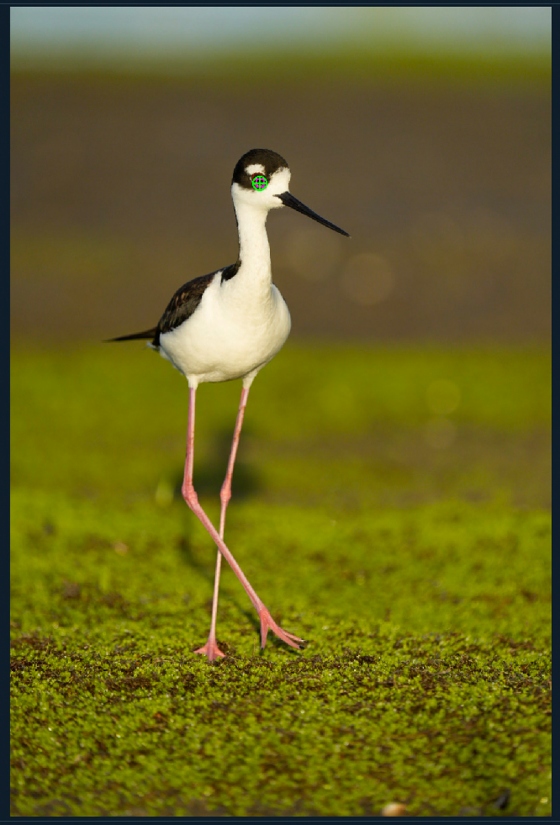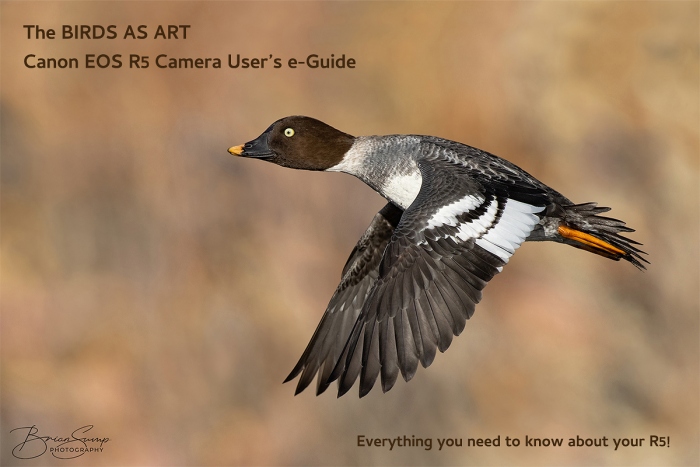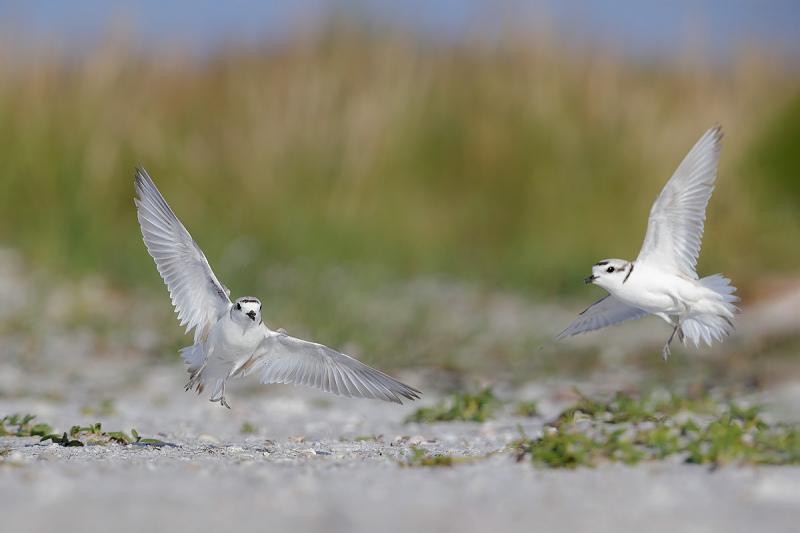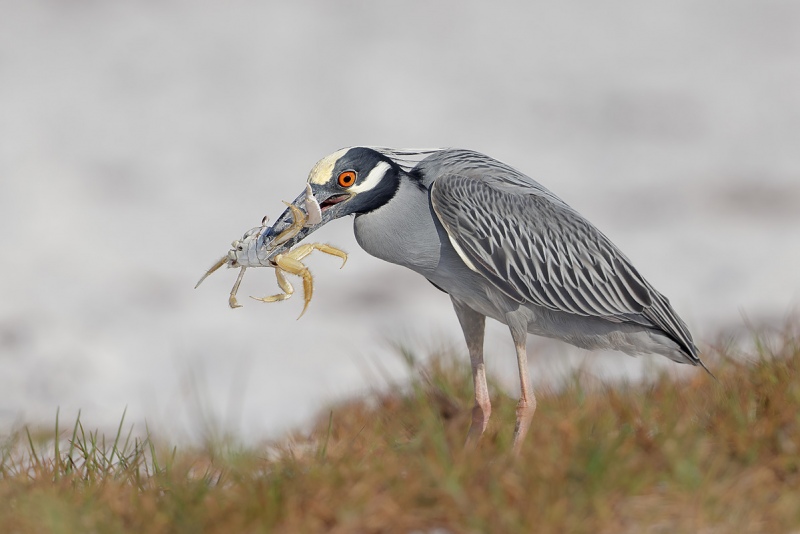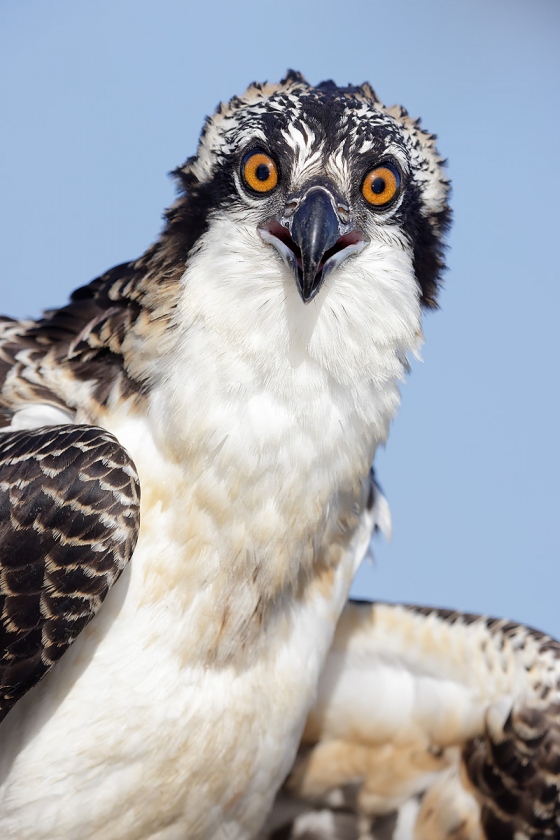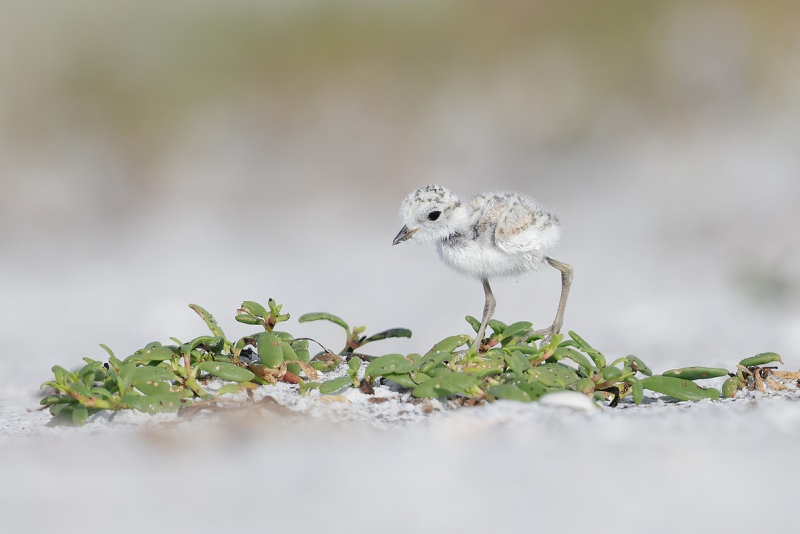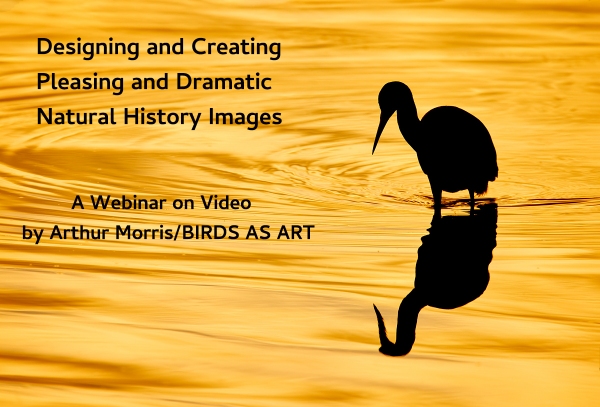What’s Up?
I left the house at 6:00am on Sunday morning and headed west on SR 60 in hopes of some color sunrise tree silhouettes. That fizzled quickly so I gassed up at Jimmy’s and headed back to ILE and down to the lake. As expected, I came across the crane family at the north end of the North Field. But there was only one chick with the two adults … The young cranes often nestle down to rest in the grass where they are well camouflaged. But they had mowed that field the other day … When my careful search came up empty, it seemed that one of the two chicks had perished. I walked to end of Palmetto to check on a huge dead oak to see if there were any photo possibilities. There were not.
It was not yet seven am and I was ready to head home. But when I turned around to head back to the car, there were the adults feeding their two chicks! Hooray. I got out the 600 and the tripod and made images of the chicks — now almost half as large as their parents, for about 45 minutes working off the rear monitor and the splayed, ground-level tripod. No matter how much I practice that technique, I know that I still need lots more practice to get the perfect framing every time … IAC, I was home well before eight.
Today is Monday 14 June, 2021. Happy Flag Day to you. And a happy 75th birthday to me. To celebrate, I got to bed at 6:30pm, set the alarm for 3:00am, but woke at 1:55am. I packed the car and was headed to Clemens Van der Werf’s home in Fort Lauderdale by 2:55am. I’ll have time for a short nap if I need to stop on the way down. I will be staying two nights. We will be photographing at a Least Tern colony in Southeast Florida for three mornings. I will head home after the morning shoot on Wednesday.
Wherever you are, and whatever you are doing, I hope that you too have a great day.
This blog post took about an hour to prepare and makes 170 consecutive days with a new one. Please remember that if an item — a Delkin flash card, or a tripod head — for example, that is available from B&H and/or Bedfords and is also available in the BAA Online Store, it would be great if you opt to purchase from us. We will match any price. Please remember also to use my B&H affiliate links or to save 3% at Bedfords by using the BIRDSASART discount code at checkout. Doing either often earns you free guides and/or discounts. And doing so always earns my great appreciation.
Still Need One for Jax n-the-Field
If you are interested in four (two 1/2 and three full) days of In-the-Field Instruction at a great new spot in the Jacksonville, FL area — the afternoon of Sunday 27 June through the morning session on Thursday 1 July 2021, please get in touch ASAP via e-mail for details, or call me on my cell at 863-221-2372. If you have a four-wheel drive truck or an SUV that would do well on the beach, that would be an amazing plus. Inexpensive lodging at a gorgeous AirBnB just 25 minutes from our shooting location is available. We only have room for one more in the 4 bedroom home.
We will be going to the beach in my vehicle (unless you have a 4wD vehicle) for all eight sessions at Huguenot Memorial Park. We will have thousand of birds to photograph. Mainly nesting Royal Terns with chicks of all sizes and Laughing Gulls with large chicks and fledglings. There are nesting Brown Pelicans there as well. We will have tons of flight photography. The terns will be carrying all sorts of fish and shrimp and other prey items for the young. There may be less action for the afternoon sessions, but with any luck at all we will have the larger Royal Tern chicks (and possibly recently fledged young) swimming in the surf (along with young laughing gulls).
Sony a9 ii Mirrorless Digital Camera Body
Price reduced $103.00 12 JUNE 2021
BAA Record-low Price
Multiple IPT veteran Larry Master is offering a Sony a9 ii mirrorless digital camera body in near-mint condition (with a very low shutter count of 2340) for $2895.00 (was $2998.00). There is a single, almost microscopic scratch on the rear monitor. The sale includes the original box and everything that came in it, along with insured ground shipping via major courier to lower-48 US addresses only. Your new camera will not ship until your check clears unless other arrangements are made.
Please contact Larry via e-mail or by phone at 1-518-645-1545 (Eastern time zone).
As things turned out, the a9 and then the a9 ii turned out to be life-changers for me. From the moment I tracked that first incoming Brandt’s Cormorant, I knew that SONY a9 series bodies featured the world’ best AF. I upgraded to the a9 ii as soon as it was released for the slightly larger body size. At one point I owned two a9 ii bodies. A new a9 ii sells for $4,498.00 so you can save a very nice $1603.00 by grabbing Larry’s a9 ii ASAP. Not to mention that the new Sony A1 sells for $6498.00 … artie
|
|
|
This image was created on 2 June 2021 in the marsh on the edge the lake near my home. While seated in the wet mud, I used the hand held Sony FE 200-600mm f/5.6-6.3 G OSS lens (at 524mm) and The One, the Sony Alpha 1 Mirrorless digital camera. ISO 1000. Exposure determined via Zebras with ISO on the rear dial: 1/12500 sec. at f/6.3 (wide open) in Manual mode. (I had been set up for a potential fly-by Osprey.) AWB at 7:08am on a dead-clear morning. Wide/AF-C was active at the moment of exposure and performed as expected: perfectly. Click on the image to see a larger version. Image #1: Black-necked Stilt female on vegetation-covered mud bar |
Mommy Long-legs
The stilts liked the vegetation-covered mud bar seen in today’s featured image. And they visited it often. It was midway between the two original nests. The day before, when neither bird had been on eggs (I always check with my binoculars before heading down), I took ten minutes to clean up the bar. I picked up several dozen clam and mussel shells along with more than a few shed feathers. The next day my clean-up efforts paid off in spades. I often do the same thing at the beach. If there is a nice stretch of sand with a few distracting shells, I will tidy up, take a seat, and wait for the shorebirds to return to that stretch of beach.
If anyone knows the name of the fresh-water ground-cover vegetation — it grows below the water and does well as things dry up — please leave the name in a comment. Comments on the image are welcome as well. BTW, how did I do on sun angle?
Lastly …
Do you think that this image needs some to be leveled? If yes, CW or CCW? And if yes, how did you know?
|
|
Image #1A: AF point for the Black-necked Stilt female on vegetation-covered mud bar image |
More of the Same a1 AF Magic
Nothing new here as far as a1 AF is concerned.
The Image Optmization
The screen capture above shows you what the original looked like. Despite my previous in-the-field clean-up efforts, I needed to do a bit more in Photoshop. The clean-up was one with my usual cadre of clean-up tools. Those include the Patch Tool, the Spot Healing Brush, and Content Aware Fill. Note that I did not use the Clone Stamp at all. I rarely do. A small crop from the left and below eliminated some crud along the lower frame edge. In addition, I eliminated all of the larger specular highlights and then smoothed the upper background with a Gaussian blur painted in after applying an Inverse (Black, Hide-all) Layer Mask.
|
|
The BIRDS AS ART Current Workflow e-Guide (Digital Basics II).You can order your copy from the BAA Online Store here, by sending a PayPal for $40 here, or by calling Jim or Jennifer weekdays at 863-692-0906 with your credit card in hand. Be sure to specify Digital Basics II. |
The BIRDS AS ART Current Workflow e-Guide (Digital Basics II)
The clean-up techniques mentioned above and tons more great Photoshop tips and techniques — along with all of my personalized Keyboard Shortcuts — are covered in detail in the BIRDS AS ART Current Workflow e-Guide (Digital Basics II), an instructional PDF that is sent via e-mail. Learn more and check out the free excerpt in the blog post here. While the new e-Guide reflects my MacBook Pro/Photo Mechanic/DPP 4/Photoshop workflow, folks using a PC and/or BreezeBrowser will also benefit greatly by studying the material on DB II. Note: folks working on a PC and/or those who do not want to miss anything Photoshop may wish to purchase the original Digital Basics along with DB II while saving $15 by clicking here to buy the DB Bundle.
Folks who learn well by following along rather than by reading can check out the complete collection of MP 4 Photoshop Tutorial Videos by clicking here. Note: all of the videos are now priced at an amazingly low $5.00 each.
You can learn how and why I converted all of my Canon digital RAW files in DPP 4 in the DPP 4 RAW Conversion Guide here. More recently, I became proficient at converting my Nikon RAW (NEF) files in Adobe Camera Raw. About two years ago I began converting my Nikon and Sony RAW files in Capture One Pro 12 and continue to do so today.
To purchase Capture One, please use this link. Then you can learn more about Capture One in the Capture One Pro 12 Simplified MP4 Video here. The next step would be to get a copy of Arash Hazeghi’s “The Nikon Photographers’ Guide to Phase One Capture One Pro e-Guide” in the blog post here.
You can learn advanced Quick Masking and advanced Layer Masking techniques in APTATS I & II. You can save $15 by purchasing the pair.
Typos
With all blog posts, feel free to e-mail or to leave a comment regarding any typos or errors.

